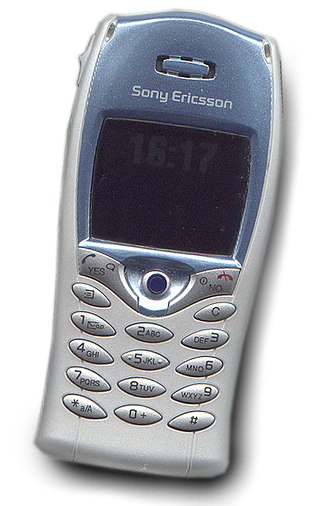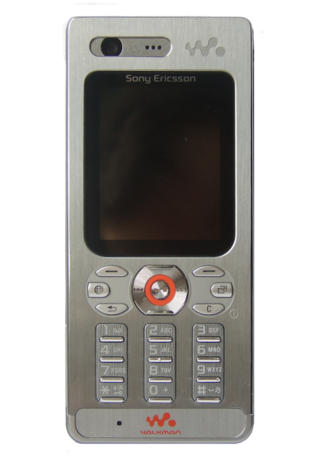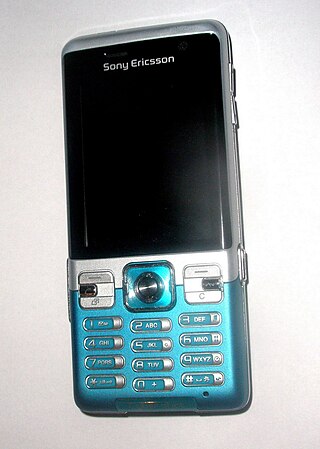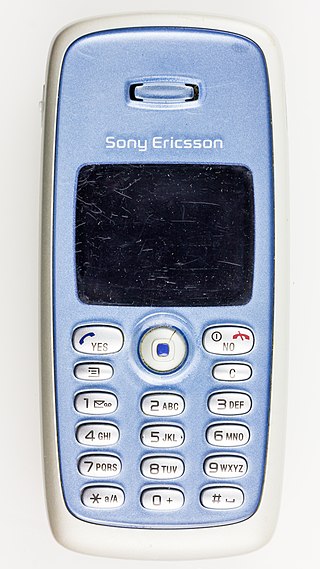
Telefonaktiebolaget LM Ericsson, commonly known as Ericsson, is a Swedish multinational networking and telecommunications company headquartered in Stockholm, Sweden. The company sells infrastructure, software, and services in information and communications technology for telecommunications service providers and enterprises, including, among others, 3G, 4G, and 5G equipment, and Internet Protocol (IP) and optical transport systems. The company employs around 100,000 people and operates in more than 180 countries. Ericsson has over 57,000 granted patents.
Sony Mobile Communications Inc. was a multinational telecommunications company founded on October 1, 2001, as a joint venture between Sony Corporation and Ericsson. It was originally incorporated as Sony Ericsson Mobile Communications, and headquartered in London, England, until Sony acquired Ericsson's share in the venture on February 16, 2012. On April 1, 2021, Sony integrated its electronics businesses including Sony Mobile into one company called Sony Corporation.

The Sony Ericsson T610, released in 2003, is a mobile phone manufactured by Sony Ericsson. It was one of the first widely available mobile phones to include a built-in digital camera, Bluetooth, color screen, joystick navigation, and was a very high selling model. The T630 was a later variant.

The Ericsson T68m was a candy-bar style mobile phone by Ericsson Mobile Communications. Launched in time for the 2001 Christmas season, the T68 was the first Ericsson mobile phone to have a colour screen, a passive LCD-STN with a resolution of 101×80 and 256 colours. Despite its diminute size, it was one of the most feature-rich mobile phones at the time, with Bluetooth, IrDA port, GPRS 3+1, tri-band compatibility, SMS with T9, EMS, WAP, and customizable monophonic ring tones. A simple bitmap image editor was provided, allowing the creation of monochrome pictures by guiding a cursor around the canvas and setting or unsetting individual pixels. These images could be set as the phone's background image in standby mode, and sent to owners of EMS-compliant phones. With EMS soon to be succeeded by the superior MMS, few owners made much use of this feature. At its release, the phone cost around € 500, GBP299 in the UK, in either two-tone grey or all-gold.

The Sony Ericsson Z500a, released in December 2004, was released through Cingular Wireless and Dobson Cellular. The phone has push-to-talk walkie-talkie functionality, but the handset was released before Cingular had rolled out their Push to Talk service.

The Sony Ericsson W900i is a 3G mobile phone manufactured by Sony Ericsson. The display of the device is a 240×320 pixel 262,000 color 2.1-inch TFT QVGA screen. It has a swivel form factor, which makes the W900 larger than many other phones when folded open. In addition to the 470 MB of internal flash memory, it also supports the Memory Stick PRO Duo as external memory. It has class 10, 32–48 kbit/s GPRS. The W900 can achieve data transfer rates of 384 kbit/s due to its 3G technology. It also includes Bluetooth, a 2-megapixel digital camera with auto-focus and the ability to take QVGA video at 30 frame/s supplemented by a second VGA camera used for video calling and self-portraits and most advertised of all, its ability to play MP3 audio files in Walkman mode for up to 30 hours and its ability to play long length MPEG-4 videos. When using the W900i as a phone, the standby time is up to 379 hours and talktime of up to 8 hours and 40 minutes. Its dimensions are 109 mm × 24 mm × 49 mm and its weight is 148 g (5.2 oz). It also has an internal NVIDIA GoForce 4800 graphics processor and was bundled with the HPM-80 headset.

The Sony Ericsson K800i, and its variant, the Sony Ericsson K790, are mobile phone handsets manufactured by Sony Ericsson. Launched in July 2006, the phones are the successor to the Sony Ericsson K750i, and are the first to be tagged with the Cyber-shot branding. Both of the phones feature a 3.2-megapixel digital camera complete with a xenon flash, a protective lens cover, and a new "BestPic" bracketing feature. The new "BestPic" feature takes 9 full quality snapshots of a subject in quick succession, allowing the user to choose the best shots from them. On the entertainment front, the phones have a media player supporting MP3, AAC/AAC+/eAAC+ and WMA music files and 3GP/MPEG-4 video files. The phones also feature a RDS FM radio, and a Memory Stick Micro (M2) slot for expandable solid state memory. The K790/K800 models are also the first Sony Ericsson mobile phones to use ATI's Imageon 2192 graphics engine, which delivers a full 3D gaming graphics for Java and full support for its 3.2-megapixel camera. It is the phone used by James Bond in the 2006 Casino Royale film and trailers.

The Sony Ericsson W850i is the first 3G slider mobile phone by Sony Ericsson, introduced in Q2 2006. It is a member of their Walkman line, succeeding the Sony Ericsson W600. The phone made its first public appearance in the 2006 movie The Da Vinci Code, months before its release. It is similar mechanically to the Sony Ericsson K800i, but differs in form factor, use of the Memory Stick PRO Duo instead of the Memory Stick Micro, and camera quality.
Dual front is a design concept which allows a device to have two distinctive sides, one for each function. It is most commonly used in camera phones.

The W810 is a camera phone produced by Sony Ericsson. It was released in January 2006. It is the successor of the W800.

The Sony Ericsson W880i is a mobile phone that was announced on 6 February 2007 and released in spring 2007. Part of Sony Ericsson's Walkman series, the phone has been popular due to its tiny dimensions and low weight. At only 9.4 mm thick, the W880 was one of the few phones on the market that were thinner than 1 cm (10 mm), the other notable example being the Nokia 5310 from later that year.

The Sony Ericsson W200 Walkman is a cellphone measuring 101 × 44 × 18mm and weighs 85g (3 oz). It features a VGA camera, an FM radio, and Sony's Walkman software, although it lacks Bluetooth.

The Sony Ericsson K850i is a high-end mobile phone when released in October 2007. It was announced in June 2007 as the flagship product in Sony Ericsson's K ("Kamera") series, with a 5 megapixel CMOS camera sensor. The K850 was the first Sony Ericsson phone released outside of NTT DoCoMo to support microSD and microSDHC along with Sony's traditional M2. It also introduces the usage of three touch-sensitive softkeys right under the display and a new form of navigation button, omitting the classic joystick introduced with the Ericsson T68. The camera interface has been revamped to resemble the format of cybershot digital cameras. According to the manufacturer the UMTS talk time has been significantly increased to 3 hours 30 min over its predecessor, the K800 and K810.. It was Sony Ericsson's first 3.5G HSDPA supporting mobile phone, and was also the first 3G "global" mobile with supporting all major operating network frequency in the world including GSM 850, GSM 900, GSM 1800, GSM 1900, HSDPA, UMTS 850, UMTS 1900, UMTS 2100.
The Sony Ericsson W580i is a mid range slider style mobile phone in the Walkman series. The phone was announced on 26 March 2007 and was released in early August. It is a 2.5G Quad-band (850/900/1800/1900) GSM phone with EDGE capabilities and has a 2 megapixel camera. It comes in "Style White", "Boulevard Black", "Metro Pink", "Urban Grey", "Jungle Green" and "Velvet Red".

The Xperia X1 is a high-end smartphone from Sony Ericsson, and is the first in the manufacturer's Xperia series. The phone was designed and built by Taiwanese OEM HTC. The X1 was first presented at the 2008 Mobile World Congress.

Sony Ericsson C702 is a mobile phone handset manufactured by Sony Ericsson. The phone features a 3.2-megapixel digital camera with LED flash and a few features such as geo-tagging and face detection. On the entertainment front, the phone has a media player supporting MP3, AAC/AAC+/eAAC+ and WMA music files and 3GP/MPEG-4 video files. The phone also features a RDS FM radio, and a Memory Stick Micro (M2) slot for expandable solid state memory
The Sony Ericsson F305 is a GSM mobile phone created and developed by Sony Ericsson in the FUN SERIES. It was first released in November 2008. It is especially designed for gamers, like the Sony Ericsson F500 which was released in 2004.

The Sony Ericsson Xperia X10 is a 2010 high end smartphone in the Xperia series produced by Sony Ericsson. It was the first Sony Ericsson smartphone to run the Android operating system, and was designed to be the successor of the Xperia X2. The phone was shipped with Android 1.6 (Donut), but an upgrade to 2.1 (Eclair) was made available starting 31 October 2010, with a gradual international rollout. Originally, Sony Ericsson stated that the X10 would not receive an upgrade to Android 2.2 (Froyo) or beyond, but the phone was later upgraded to 2.3.3 (Gingerbread) with the updates starting on 29 July 2011.

The Sony Ericsson T300 is an entry-level GSM mobile phone, and one of the first with a colour screen. It was released in October 2002. The Cingular variant, the T306, was released in December 2002.















